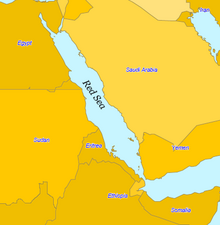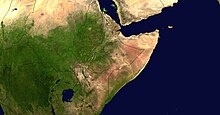Red Sea Dam


The Red Sea Dam is a speculative macro-engineering proposal to shut off and lower the Red Sea by means of a dam, which has been tangible since the 1960s and which scientists and engineers at the University of Utrecht took up and developed further in 2007 . While the authors' intent is to explore "the ethical and environmental dilemmas and some of the policy implications of macro-engineering," the proposal has drawn both criticism and ridicule.
suggestion
The Red Sea would be cordoned off at its southern exit between Djibouti and Yemen , where the Bab al-Mandab is only 27 km wide, or between Yemen and Eritrea . The natural evaporation ( evaporation ) would quickly lower the level of the closed Red Sea. Controlled inflow of water through the dam could drive turbines to generate electricity. One estimate assumes that up to 50 gigawatts of electrical power could be provided. This would put all other power plants on earth in the shade.
The dam would be 150 m high, 1 km thick and (in the variant between Yemen and Eritrea) 100 km long. After 50 years the 450,000 km² surface of the Red Sea would be reduced by a third and after 300 years by two thirds. Its water level would then have dropped by around 600 m.
Effects
The authors of the proposal, Roelof Dirk Schuiling, Viorel Badescu, Richard B. Cathcart, Jihan Seoud and Jaap C. Hanekamp from the University of Utrecht , admit that “macro-engineering projects of this size would cause massive destruction of existing ecology” . This aspect is particularly emphasized by critics, with references to damage that has already been observed in much smaller projects.
The authors claim “green” qualities for the idea: “On the positive side of the environmental impact, there are the large reductions in greenhouse gas emissions and the reduced rate of depletion of fossil hydrocarbon stocks”.
Experts like Peter Bosshard, Policy Director of International Rivers , have condemned the plan as insane.
The area around the proposed dam is known for its volcanism , as the banks on the Arabian Plate and Nubian Plate move apart. That is why the dam's planners are considering a construction (not explained in more detail) than in their 2001 proposal for a dam in the Strait of Hormuz .
With the separation of the Red Sea from the Indian Ocean, Egypt , Israel and Jordan would no longer have quick access to Asian shipping routes, and Mecca and Sudan would completely lose their seaports . The Suez Canal, an important shortcut of the sea routes between Europe and Asia, would become useless, so that the ships would have to sail all over Africa again .
The global rise in sea level due to the dam would be around 30 cm.
Other macro-engineering suggestions
- Atlantropa (barrier of the Mediterranean near Gibraltar)
- Qattara Valley Hydrosolar Energy Project
- Davydov Plan (diversion of the Siberian rivers to the south)
Web links
- Gibraltar Strait Dam Macroprojects by Richard Cathcart, one of the authors of the Red Sea Dam proposal
- Proposal: 50 gigawatts If They Dam The Red Sea . Tom's hardware.
- A Red Sea Dam: Huge Power and Massive Destruction . SCItizen.
- Dam The Red Sea And Release Gigawatts . Science Daily.
Individual evidence
- ↑ Roelof Dirk Schuiling, Viorel Badescu, Richard B. Cathcart, Jihan Seoud, Jaap C. Hanekamp: Power from closing the Red Sea: economic and ecological costs and benefits following the isolation of the Red Sea . In: International Journal of Global Environmental Issues . Volume 7, No. 4 (October – December), 2007, pp. 341-361 ( abstract inderscience.com [accessed January 9, 2014]).
- ↑ a b c d Red Sea mega-dam would be 'irresponsible' . New Scientist . December 7, 2007. Retrieved January 9, 2014.
- ^ A b Plans for gigantic Red Sea dam slammed . Dive Magazine. December 7, 2007. Retrieved January 9, 2014.
- ^ Dam on Red Sea Would Harm Environment . LiveScience. December 6, 2007. Retrieved January 9, 2014.
- ↑ Volcano erupts on Red Sea island . BBC . October 1, 2007. Retrieved January 9, 2014.
- ↑ Viorel Badescu, Richard B. Cathcart (ed.): Macro-engineering Seawater in unique environments . Springer Science + Business Media , 2011, ISBN 978-3-642-14778-4 , pp. 128 ff . ( Google Books [accessed January 9, 2014]).
